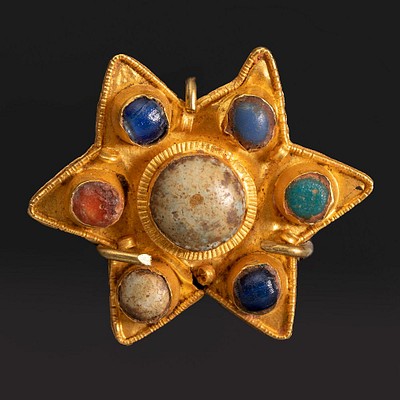JULIO ROMERO DE TORRES (Cordoba, 1874 - 1930). "Arab looking at the sea", ca.1903. Oil on panel.
Lot 118
About Seller
Setdart Auction House
Carrer Aragó 346
Barcelona
Spain
Setdart Subastas was born in 2004 and is currently the first online art auction in Spain with solidity, prestige and reliability guaranteed by our more than 60,000 users. Setdart has a young, dynamic and enterprising team ready to successfully manage the purchase and sale of art works through custom...Read more
Estimate:
EUR€18,000 - EUR€20,000
$19,354.84 - $21,505.38
Absentee vs Live bid
Two ways to bid:
- Leave a max absentee bid and the platform will bid on your behalf up to your maximum bid during the live auction.
- Bid live during the auction and your bids will be submitted real-time to the auctioneer.
Bid Increments
| Price | Bid Increment |
|---|---|
| EUR€0 | EUR€10 |
| EUR€200 | EUR€25 |
| EUR€500 | EUR€50 |
| EUR€1,000 | EUR€100 |
| EUR€3,000 | EUR€200 |
| EUR€5,000 | EUR€500 |
| EUR€10,000 | EUR€1,000 |
| EUR€20,000 | EUR€2,000 |
| EUR€50,000 | EUR€5,000 |
About Auction
By Setdart Auction House
Dec 21, 2021
Set Reminder
2021-12-21 07:30:00
2021-12-21 07:30:00
America/New_York
Bidsquare
Bidsquare : Córdoba: 2,000 Years of Art
https://www.bidsquare.com/auctions/setdart-auction-house/c-rdoba-2-000-years-of-art-8049
Setdart Auction House sofia@setdart.com
Setdart Auction House sofia@setdart.com
- Lot Description
JULIO ROMERO DE TORRES (Cordoba, 1874 - 1930). "Arab looking at the sea", ca.1903. Oil on panel. Work registered in "The splendor of the dawn; Julio Romero de Torres", 2016 p.26. Signed and located in the lower left corner. Measurements: 22.5 x 13.5 cm; 42.5 x 33 cm (frame). In 1903, Julio Romero de Torres undertook a trip to Morocco with his brother Enrique Romero. Both explored the city which influenced Julio's painting, who dedicated several works inspired by orientalism, an example of this is his painting La Monta, Calle de Tánger, and this work where you can appreciate both the theme of oriental inspiration, as a type of loose brushstroke characteristic of the time. Julio Romero de Torres was born in an intellectual and artistic environment, which decidedly favored his vocation. His father, Rafael Romero de Barros, was also a painter and curator of the Museum of Fine Arts in Cordoba. Julio Romero began his training in 1884, combining classes at the Conservatory of Music with his father's drawing and painting classes. In 1890 we find his first known work, "La huerta de Morales", and in 1895 he entered for the first time in the National Exhibition of Fine Arts, with "Mira qué bonita era", a work that earned him an honorable mention and was acquired by the State. In 1897 he opted for the Rome prize, although he did not win the scholarship, and in 1902 he began his teaching career at the School of Fine Arts in Cordoba. The following year he moved to Madrid to learn first hand about the mural painting of the symbolists, after receiving his first major commission, a series of murals dedicated to the arts for the Círculo de la Amista de Córdoba. In this project his work still shows the influence of Puvis de Chavannes. Julio Romero then remained in Madrid, in contact with the circle of Valle-Inclán and Machado, frequenting the gatherings of the Café de Levante while maturing his own style. In 1906 he sent "Vividoras del amor" to the Nacional, a work that was rejected because of its scandalous theme. In Madrid he will become known through exhibitions such as the one at the Círculo de Bellas Artes in 1907, and he matures the idea of a trip to Europe that will mark a definitive change in his language, a clear desire for change. He continues to participate in the National Exhibitions, and in 1908 his work "The Gypsy Muse" is acquired by the State and earns him a first medal. This triumph will make that his paintings are sent to exhibitions held abroad, in Buenos Aires and Santiago de Chile. The definitive recognition came in 1910, when he was awarded the Order of Alfonso X the Wise and was appointed inspector of the delegation and royal commissariat at the Art Exhibition in Rome. The following year he was awarded the gold medal at the National Fine Arts of Barcelona, and shortly after he was appointed full member of the Academy of Sciences, Fine and Noble Arts of Cordoba. Julio Romero, however, continued to live in Madrid, frequenting the Café Pombo gathering since 1913. Two years later a special room was dedicated to him at the National Exhibition, and in 1916 he was appointed professor at the Academy of San Fernando. During these years of success and recognition, his studio, in Madrid's Pelayo Street, became the center of gatherings and meetings. However, in 1928 he was forced to return to Cordoba for health reasons, although this did not prevent him from continuing to paint in his studio in the Plaza del Potro. In fact, in 1930, the same year of his death, he participated in the Ibero-American Exposition of Seville with a total of twenty-eight paintings. Although, like many of his contemporaries, Julio Romero began his career cultivating a regionalist work that would evolve along the lines of symbolism.
- Shipping Info
-
In-house shipping available. Please inquire at admin@setdart.com.
-
- Buyer's Premium



 EUR
EUR CAD
CAD AUD
AUD GBP
GBP MXN
MXN HKD
HKD CNY
CNY MYR
MYR SEK
SEK SGD
SGD CHF
CHF THB
THB















